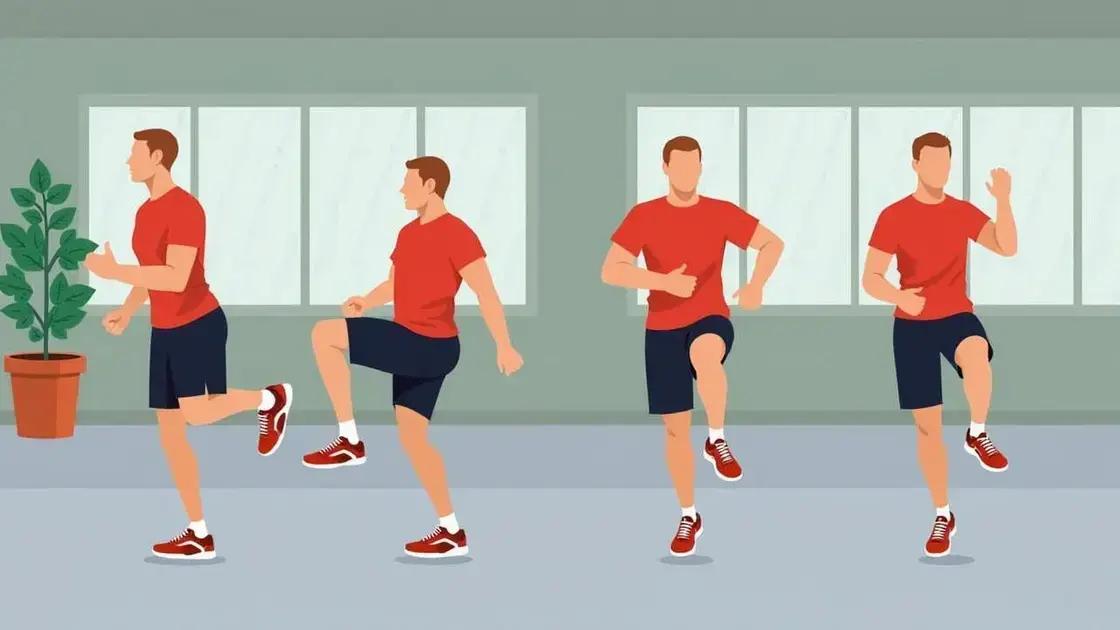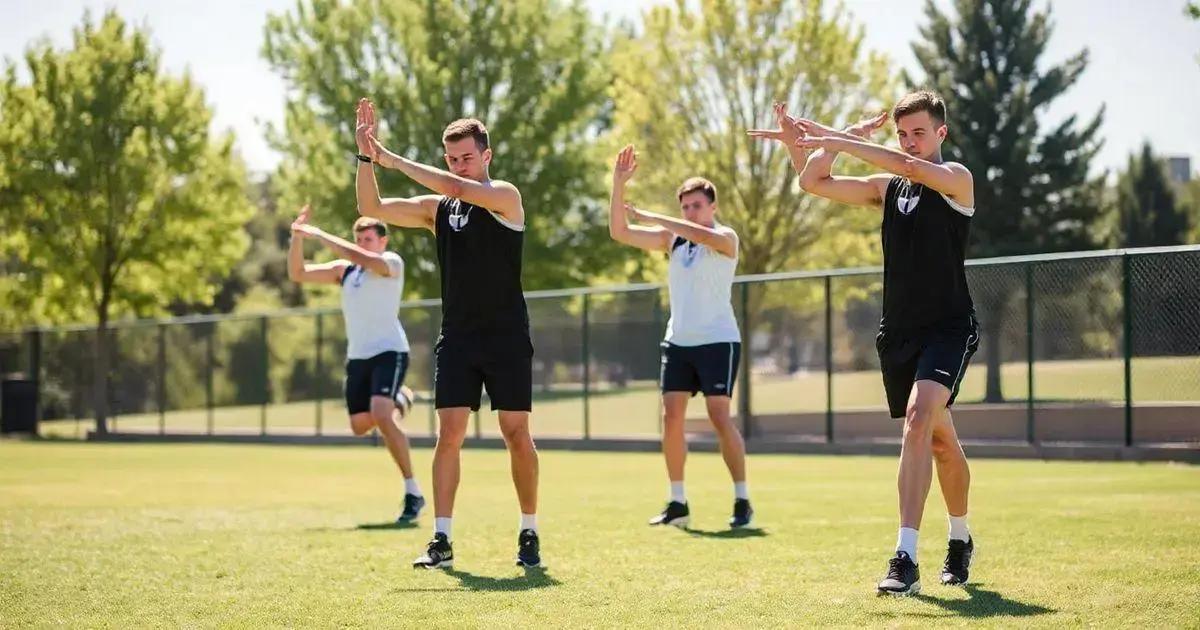The Role of Arm Swings in Dynamic Warm-Ups is crucial for enhancing flexibility, improving blood flow, and reducing injury risk, making them essential for any physical activity. Incorporate controlled arm swings into your routine for optimal performance during workouts.
The Role of Arm Swings in Dynamic Warm-Ups is crucial for anyone looking to maximize their athletic performance. Arm swings, often overlooked, play a pivotal role in preparing the body for rigorous activities. By engaging in these simple yet effective movements, athletes can enhance their range of motion, improve circulation, and reduce the risk of injury. This article delves into the science behind dynamic warm-ups, emphasizing the importance of arm swings in any pre-exercise routine.
Understanding Dynamic Warm-Ups

Dynamic warm-ups are essential for preparing your body before any physical activity. Unlike static stretching, dynamic warm-ups involve movement and help improve flexibility, strength, and range of motion. These exercises are designed to increase blood flow to your muscles, making them more pliable and ready for action.
Why Dynamic Warm-Ups Matter
Incorporating dynamic warm-ups into your routine can lead to better performance and reduced injury risk. By warming up through movement, you activate your muscles and nervous system, enhancing coordination and reaction time. This is especially important for athletes who engage in explosive or high-intensity sports.
Components of Dynamic Warm-Ups
Dynamic warm-ups often include a variety of movements aimed at different parts of the body. Key components typically involve:
– Leg swings to warm up the hip flexors and hamstrings.
– Arm circles to loosen up the shoulders and upper body.
– High knees and butt kicks to elevate heart rate.
Timing and Duration
A good dynamic warm-up should last around 10 to 15 minutes. This duration allows the body sufficient time to transition from rest to readiness. Pay attention to how your body feels during these movements; if anything feels tight, be sure to focus on that area.
Getting Started
Make dynamic warm-ups a regular part of your exercise routine. Tailor your warm-up to the specific activity you plan to do, ensuring all targeted muscle groups are prepared. By understanding the importance of dynamic warm-ups, you set yourself up for a successful workout or athletic performance.
Benefits of Arm Swings

Arm swings are a key part of dynamic warm-ups that provide many benefits. Incorporating arm swings into your routine can enhance your performance and help prevent injuries. Here are some of the standout benefits:
Enhances Flexibility
Arm swings promote flexibility in your shoulders and upper body. This improved flexibility allows for a greater range of motion during workouts and sports. With regular practice, you may find it easier to perform various exercises, which can lead to better results.
Improves Blood Flow
Dynamic arm swings increase blood circulation throughout your upper body. This boost in blood flow warms up the muscles and prepares them for the physical demands of your activity. When your muscles are warmed up, you reduce the likelihood of strains or pulls.
Enhances Coordination and Balance
Incorporating arm swings helps improve your coordination. Moving your arms in sync with your legs during exercises promotes body awareness and balance. This is particularly beneficial in sports where timing and coordination are critical for success.
Boosts Mental Focus
Engaging in arm swings can serve as a mental cue to prepare for your workout or activity. As you perform these movements, your mind shifts its focus towards the upcoming physical effort. This helps create a positive mindset, enhancing your overall performance.
By understanding these benefits, you can see how vital arm swings are in dynamic warm-ups. They prepare both your body and mind for the challenges ahead.
How to Incorporate Arm Swings

Incorporating arm swings into your warm-up routine is simple and effective. Here are some steps to guide you on how to correctly perform arm swings:
1. Start with Proper Posture
Stand tall with your feet shoulder-width apart. Keep your knees slightly bent. Engage your core to maintain balance. Good posture helps you perform movements more effectively and safely.
2. Begin with Small Swings
Start with small, controlled arm swings. Extend your arms out to the sides at shoulder height. Swing them forward and backward in a gentle motion. Focus on keeping your movement smooth and steady.
3. Gradually Increase Range
Once you feel comfortable with small swings, gradually increase the range of motion. As you swing your arms back, allow them to go further behind you. When swinging forward, reach toward the front without straining.
4. Incorporate Variations
To target different muscles, try variations of arm swings. For example, cross-body swings involve crossing your arms in front of your chest with each swing. Another option is overhead swings, where you lift your arms up and down.
5. Work with Your Breath
Coordinate your breathing with your movements. Inhale as your arms lift and open, and exhale as they swing back down. This connection helps improve your overall focus and relaxation.
6. Duration and Repetitions
Perform arm swings for about 1-2 minutes. Aim for at least 15-20 swings in each direction. Adjust the duration based on your comfort level and needs. This will effectively ready your muscles for exercise.
By following these steps, you can seamlessly add arm swings to your dynamic warm-ups. This preparation can set the stage for a successful workout.
Common Mistakes to Avoid

When incorporating arm swings into your dynamic warm-ups, it’s important to avoid common mistakes that can hinder your effectiveness and increase the risk of injury. Here are some key pitfalls to watch out for:
1. Skipping the Warm-Up
One major mistake is neglecting to warm up before starting arm swings. Skipping this step can lead to stiffness and increase the chance of injury. Always begin with light movements to get your blood flowing.
2. Using Excessive Force
Many people make the error of swinging their arms too forcefully. This can strain your muscles and joints. Focus on controlled, smooth movements rather than using excessive force.
3. Poor Posture
Maintaining poor posture during arm swings can limit effectiveness and increase injury risk. Always keep your back straight, shoulders relaxed, and neck aligned to prevent strain.
4. Ignoring Breathing Techniques
Failing to coordinate your breath with your movements is another common mistake. Make sure to breathe deeply and rhythmically as you perform arm swings. This helps keep your body relaxed and focused.
5. Not Listening to Your Body
Ignoring your body’s signals can lead to injuries. If you feel pain or discomfort while performing arm swings, stop and assess your form. Modify or reduce the intensity as needed to ensure safety.
6. Performing Arm Swings Too Quickly
Rushing through arm swings diminishes their effectiveness. Consistency and control are essential. Take your time, focusing on each swing to maximize the benefits and prepare your body adequately.
By avoiding these common mistakes, you can enhance the effectiveness of arm swings in your dynamic warm-ups and ensure a safe and beneficial workout.
In summary, the importance of arm swings in dynamic warm-ups
Arm swings play a crucial role in preparing your body for physical activity by enhancing flexibility and improving blood flow.
By incorporating them into your warm-up routine, you can boost coordination and mental focus, leading to better performance during workouts or sports.
Avoid common mistakes, and focus on proper technique to maximize the benefits of arm swings. This effective movement not only helps prevent injuries but also optimizes your overall workout results.
Remember, investing time in a well-structured warm-up, including arm swings, sets the foundation for success in your fitness journey.
FAQ – Frequently Asked Questions About Arm Swings in Dynamic Warm-Ups
What are arm swings and why are they important?
Arm swings are dynamic movements that warm up and prepare your upper body for physical activity, enhancing flexibility and circulation.
How long should I perform arm swings during a warm-up?
Aim to perform arm swings for about 1-2 minutes, doing 15-20 swings in each direction to optimize their benefits.
Can anyone do arm swings, or are they for advanced athletes only?
Anyone can do arm swings! They are beneficial for athletes of all levels and can be easily incorporated into any warm-up routine.
What common mistakes should I avoid while doing arm swings?
Common mistakes include using excessive force, having poor posture, skipping the warm-up, and not coordinating your breath with the movements.
Are there variations of arm swings I can try?
Yes, you can try variations like cross-body swings, overhead swings, and small to large range swings to target different muscle groups.
How do arm swings help in injury prevention?
By warming up the muscles and improving flexibility and coordination, arm swings help reduce the risk of injuries during physical activity.












